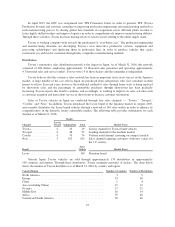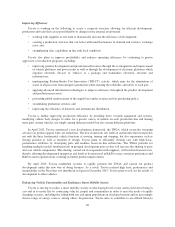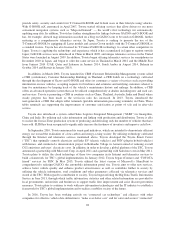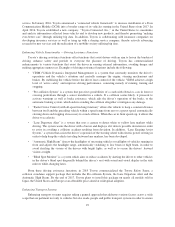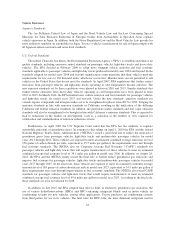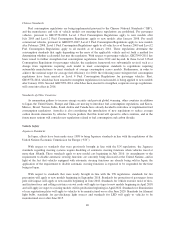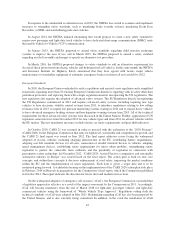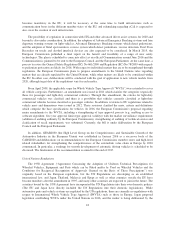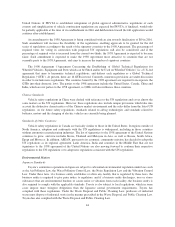Toyota 2015 Annual Report Download - page 39
Download and view the complete annual report
Please find page 39 of the 2015 Toyota annual report below. You can navigate through the pages in the report by either clicking on the pages listed below, or by using the keyword search tool below to find specific information within the annual report.Vehicle Emissions
Japanese Standards
The Air Pollution Control Law of Japan and the Road Vehicle Law and the Law Concerning Special
Measures for Total Emission Reduction of Nitrogen Oxides from Automobiles in Specified Areas regulate
vehicle emissions in Japan. In addition, both the Noise Regulation Law and the Road Vehicles Law provide for
noise reduction standards on automobiles in Japan. Toyota’s vehicles manufactured for sale in Japan comply with
all Japanese exhaust emission and noise level standards.
U.S. Federal Standards
The federal Clean Air Act directs the Environmental Protection Agency (“EPA”) to establish and enforce air
quality standards, including emission control standards on passenger vehicles, light-duty trucks and heavy-duty
vehicles. The EPA decided in February 2000 to adopt more stringent vehicle emission and fuel economy
standards applicable to passenger vehicles and light-duty trucks produced in model years 2004 and beyond. In the
standards adopted for model years 2004 and beyond, manufacturers must guarantee that their vehicles meet the
requirements for ten years or 120 thousand miles, whichever occurs first. Manufacturers are not permitted to sell
vehicles in the United States that do not meet the standards. In April 2007, EPA regulations that further restrict
emissions from passenger vehicles and light-duty trucks operating at cold temperatures became effective. The
new emission standards set by these regulations were phased in between 2010 and 2013. Similar standards that
further restrict emissions from heavy-duty vehicles operating at cold temperatures have been phased in from
2012 to 2015. In March 2014, the EPA finalized new vehicle emission and fuel standards for passenger vehicles
and light-duty trucks for model years 2017 and onwards. Under the new standards, emission standards for
volatile organic compounds and nitrogen oxides are to be strengthened in phases from 2017 to 2025, bringing the
emission standards in line with emission standards in California, resulting in the unification of the differing
California and federal emission standards. In addition, the particulate matter standards and fuel vapor emission
standards will also be strengthened to be brought in line with California’s emission standards. This is expected to
lead to reductions in the burden on development, such as a reduction in the number of tests required for
certification and standardization of emission reduction systems.
Furthermore, in April 2007 the U.S. Supreme Court ruled that the EPA has the authority to regulate
automobile emissions of greenhouse gases. In response to this ruling, on April 1, 2010 the EPA and the federal
National Highway Traffic Safety Administration (“NHTSA”) issued a joint final rule to reduce the emission of
greenhouse gases from passenger vehicles, light-duty trucks and medium-duty passenger vehicles for model
years 2012 through 2016. These vehicles are required to meet an estimated combined average emissions level of
250 grams of carbon dioxide per mile, equivalent to 35.5 miles per gallon if the requirements were met through
fuel economy standards. The NHTSA also set Corporate Average Fuel Economy (“CAFE”) standards for
passenger vehicles and light-duty trucks that will require manufacturers of those vehicles to meet an estimated
combined average fuel economy level of 34.1 miles per gallon in model year 2016. In addition, on August 28,
2012, the EPA and the NHTSA jointly issued the final rule to further reduce greenhouse gas emissions and
improve fuel economy for passenger vehicles, light-duty trucks and medium-duty passenger vehicles for model
years 2017 through 2025. In the final rule, these vehicles are required to meet an estimated combined average
emission level of 163 grams of carbon dioxide per mile in model year 2025, equivalent to 54.5 miles per gallon if
these requirements were met through improvements in fuel economy standards. The NHTSA also issued CAFE
standards for passenger vehicles and light-duty trucks that would require manufacturers to meet an estimated
combined average fuel economy level of 49.6 miles per gallon in model year 2025. According to the final rule,
these standards are to be reevaluated by 2018.
In addition, in July 2015, the EPA adopted final rules to limit, in relation to greenhouse gas emissions, the
use of various hydroflourocarbons (HFCs) and HFC-containing refrigerant blends used in motor vehicle air
conditioning systems for new vehicles, among other applications. Toyota purchases air conditioning systems
from third parties for use in its vehicles. The final rules list HFC-134a, the most dominant refrigerant used in
34



